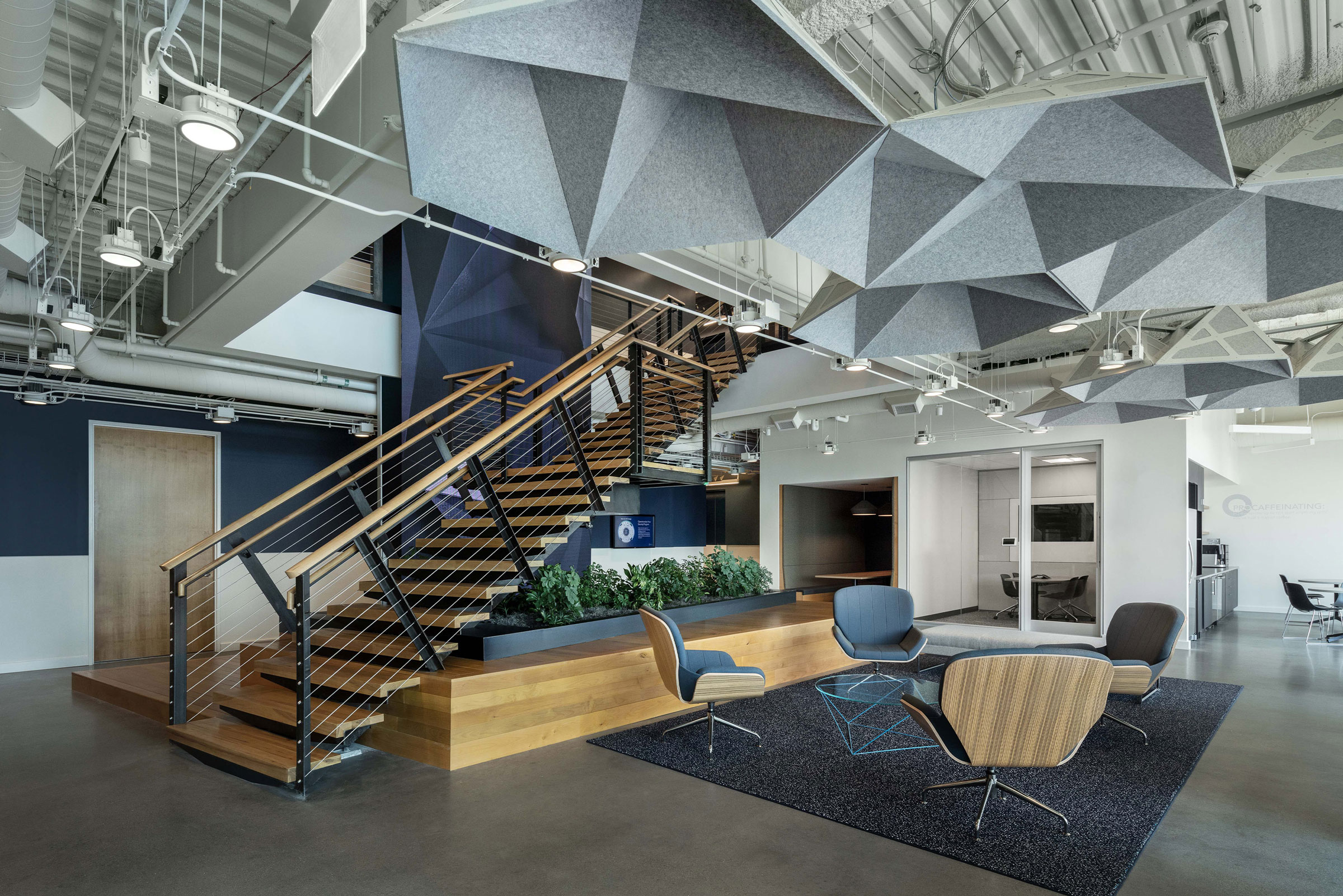Story at a glance:
- Acoustic design starts with understanding the noise reduction coefficient, or the ability of a material to effectively absorb sound.
- Some techniques for managing acoustics include adding materials such as acoustic panels or steel decking.
Implementation of acoustic design principles in architecture can mitigate frustrations caused by external noise pollution and competing internal noises within a space.
Acoustical treatments need to satisfy the needs of the people residing within the space. For example, large, open office spaces with meeting areas may need ceiling panels that absorb sound or private meeting space to work without worrying about external noise infiltration.
A basic understanding of acoustic design principles and testing methods will give you the confidence to ensure the environmental goals of your project.
What is Acoustic Design?

Custom solutions can be developed for any size space. This custom acoustic wall is based on a preconfigured system, then adapted to this specific project’s parameters at Geodis, designed by Gresham Smith and Partners in Brentwood, Tennessee. Photo by Robbins Photography
In architecture acoustic design refers to the strategies, features, and methodologies used to achieve “good sound” within a building, with the definition of “good sound” depending on what the room or building is being used for. In most cases acoustic design strives to control how soundwaves and sound energy reverberate off of a building’s interior so as to maximize vocal clarity while also reducing echoes and excessive sound transmission.
Acoustic design is largely influenced by the following sound characteristics:
- Reverberation. Reflected sounds from a sound wave created within a space.
- Reverberation time. The time required for sound reflections to decay by 60 dB until they are no longer audible and become lost in space; directly proportional to the room and indirectly proportional to the amount of sound-absorbing materials.
- Sound distribution. How sound is propagated or distributed throughout a room (e.g. directly from the source to the receiver, reflected back to the receiver at an angle from a surface, echoed to the receiver, diffracted to the receiver by flowing/bending through an object or opening, or diffused and scattered back to the receiver).
- Sound absorption. The loss of sound energy as a direct result of the sound coming into contact with an absorbent material.
Acoustic design is an integral component when it comes to the creating comfortable, healthy, and productive interior spaces.
10 Acoustic Design Principles to Consider for Your Next Project
While there is no one-size-fits-all acoustic strategy for every building project, there are several acoustic design principles that are more-or-less universal and may be practiced or applied—to varying degrees—in most spaces.
1. Understanding the Noise Reduction Coefficient Rating
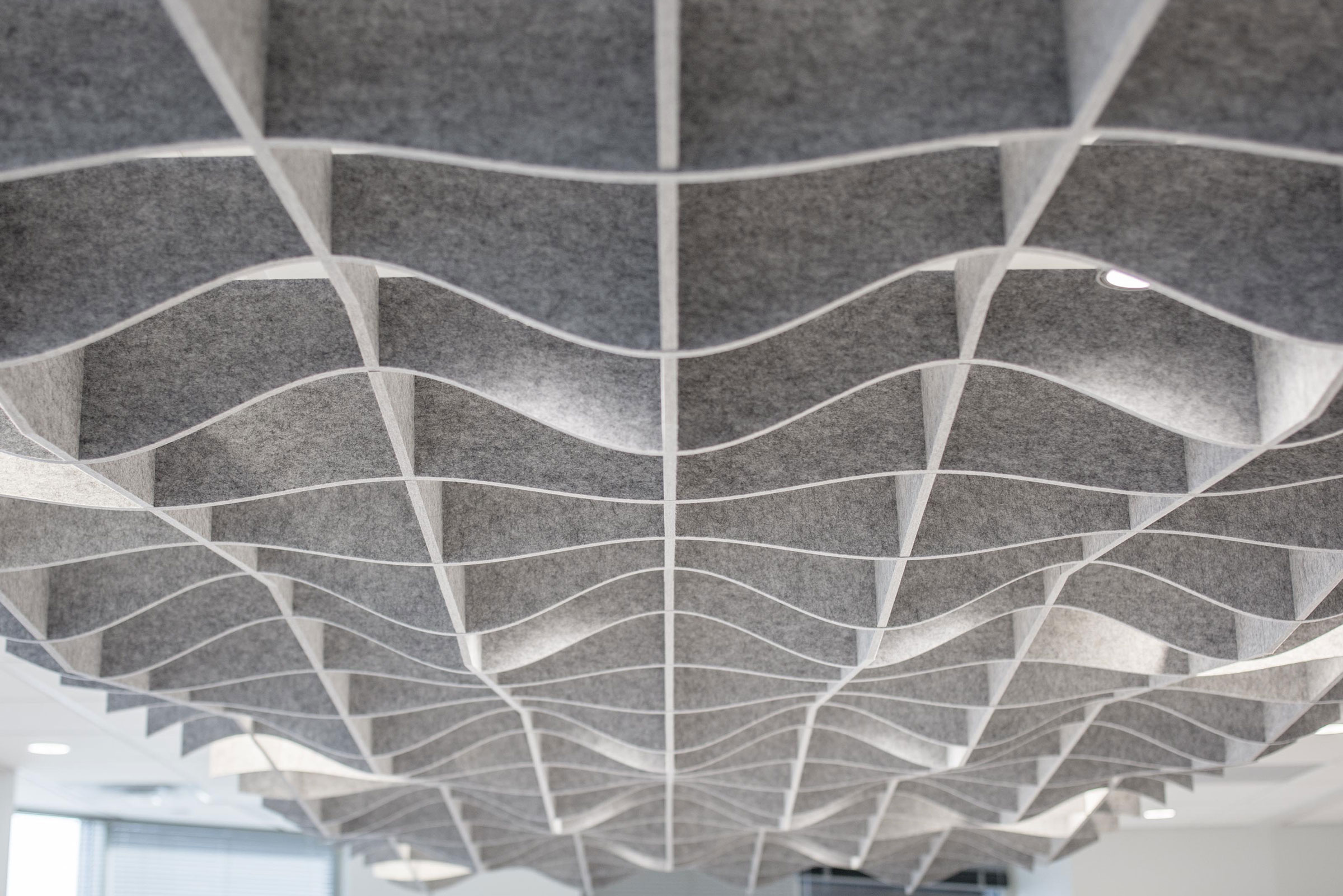
QBE Dallas in Dallas, Texas, features the Acoustic SoftGrid® Sine by Arktura. Photo by Thomas McConnell
One of the most important measurements when it comes to acoustic design is the Noise Reduction Coefficient (NRC), or the measure of a material’s ability to reflect/absorb sound in a consistent square footage.
A material’s NRC rating is expressed as a value between 0.00 and 1.00, with 0.00 indicating that sound is reflected and 1.00 indicating sound absorption. Thicker elements with 3D properties or products with exposed edges can achieve values higher than 1.00 because of the additional surface area.
An NRC rating can be a reliable indicator for a material in a space but it can also be very variable, as different materials can have a different NRC depending on how they are installed. “The NRC rating can help you choose the right material for your job, but only if it is an accurate, true rating,” John Johnston, director of systems development at Arktura, previously told gb&d.
When considering acoustic design products, Johnston recommends inquiring as to how your installation plans might impact or change the product’s NRC rating and following any suggestions offered by the manufacturer. It’s also recommended that you request the product’s laboratory testing report in order to better understand how it was installed for testing purposes and whether the results align with the design and size you may be considering.
If after all this you’re still unsure of how to interpret NRC ratings or if you feel as though you aren’t getting enough information, consult an acoustician or request third-party testing for an additional perspective.
2. Sound Insulation & Acoustic Infill
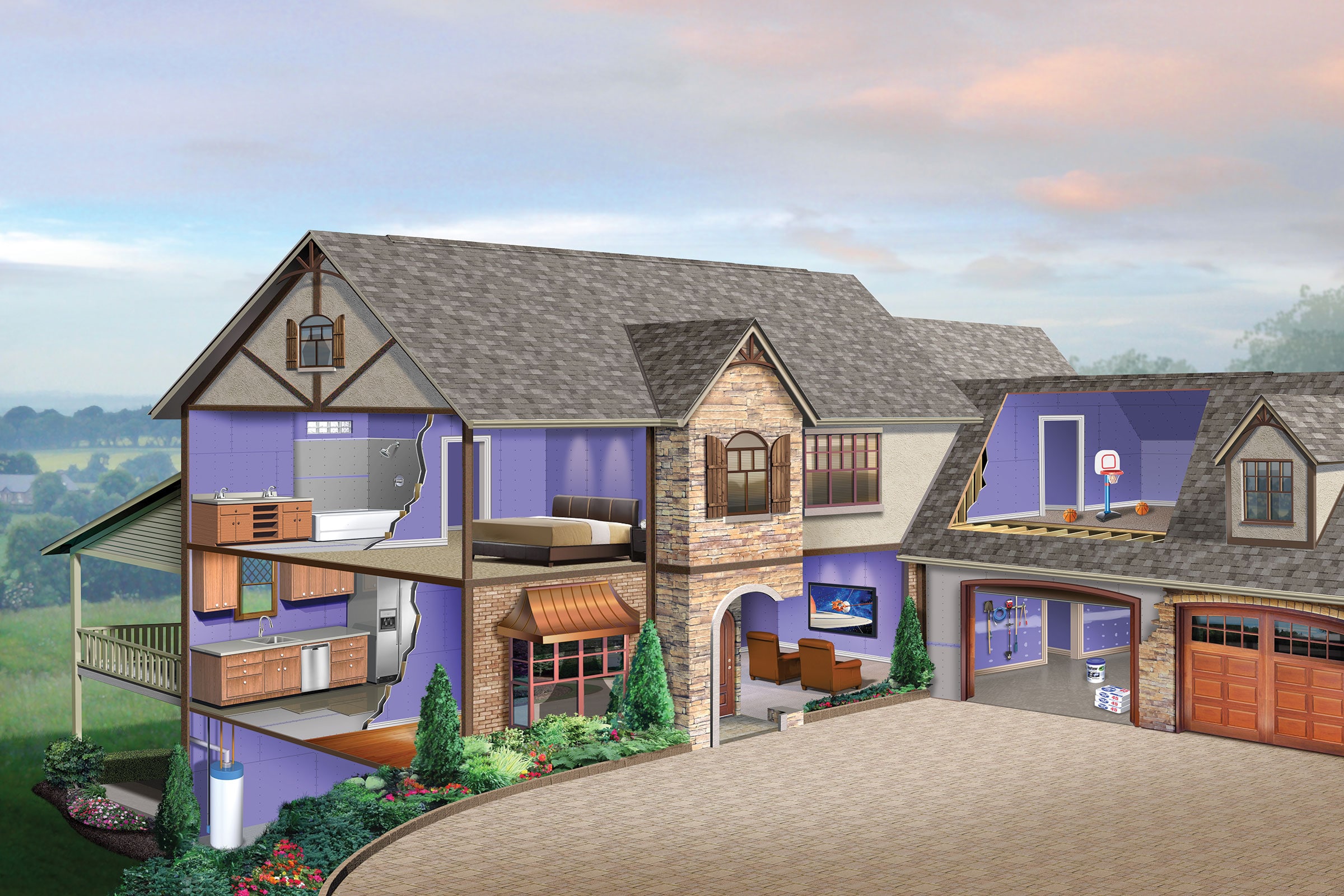
Most of National Gypsum’s PURPLE products are available nationwide, either in stock at major stores or easy to order and arrive within days. Photo courtesy of National Gypsum
Insulation is an essential component of any building—and while we typically think of insulation in terms of thermal regulation, it can also play a significant role in regulating acoustics. Just as conventional insulation aims to reduce the transmission of heat through a partition, soundproofing insulation is concerned with reducing both heat and noise transmission through walls, floors, and ceilings.
It’s important to understand noise from its origin when choosing a suitable sound insulation product. For noise insulation in closed spaces, dense and closed-cell materials are more preferable, while lighter materials are important for noise absorption.
AcoustiCORK’s products dissipate vibration energy into heat in each vibration cycle, resulting in low amplification at resonance in a wide range of frequencies and load-bearing capabilities.
Soundproofing is also possible with products like National Gypsum’s SoundBreak family of products, which stop noise from bleeding through to other rooms without the need for any prior demolition.
3. Sound Absorbing Panels, Partitions, and Baffles
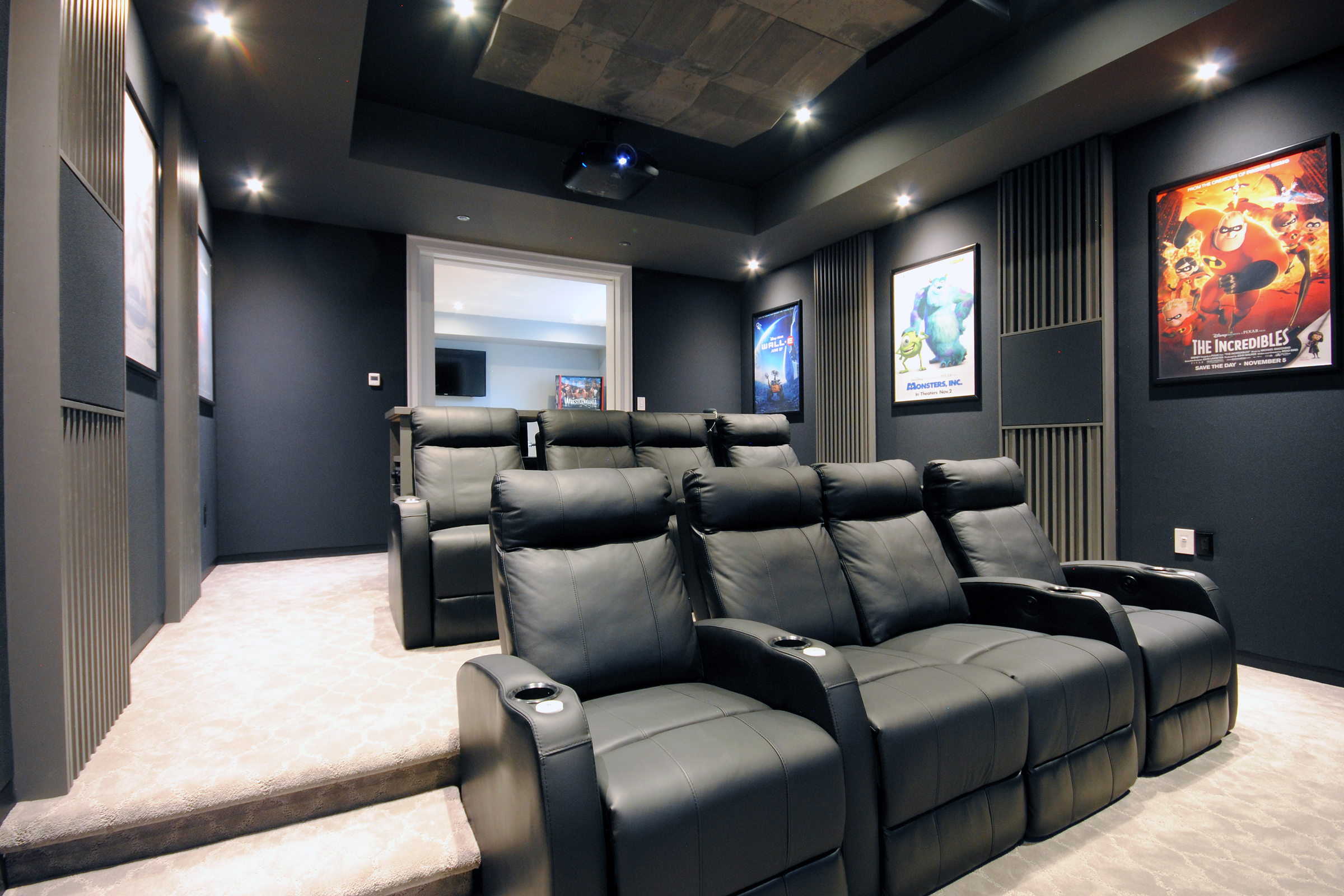
Wall- and ceiling-mounted acoustic panels help absorb sound energy. Photo courtesy of Primacoustic
When sound insulation isn’t enough—or if it would be too costly to add—the installation of acoustic sound absorption panels can be key to mitigating sound refraction, echoing, and reverberation in a room. Acoustic wall panels typically consist of an absorbing core made from either fiberglass, mineral fiber, or acoustic foam, which is then wrapped in an acrylic, polyester, or polyester-blend fabric for stylistic purposes.
“The installation of wall panels is key to mitigating sound refraction, echoing, and reverberation that can affect the listening experience,” Juan Carlos Bolomey, product manager at Primacoustic, previously told gb&d.
In some instances, however, it’s more beneficial to reduce noise before it reaches a room’s walls or ceiling, in which case acoustic screens or partitions may be favorable. Acoustic partitions may be solid or perforated and typically consist of an aluminum framework housing a large panel of sound absorption material. Depending on the style, acoustic screens may be either freestanding or mounted to the floor/ceiling—in either case, they are ideal for controlling and reducing noise in certain areas of a room.
Then there are acoustic baffles, which hang from the ceiling and absorb sound on all sides as it travels—a quality that makes them even more effective than acoustic panels. “Those [baffles] can be very effective because as sound travels through the room, it has a lot more velocity,” Bolomey says. “When you install baffles within areas where sound is moving fastest, they can help to reduce the energy of that sound as it moves through a space.”
4. Acoustic Diffusers
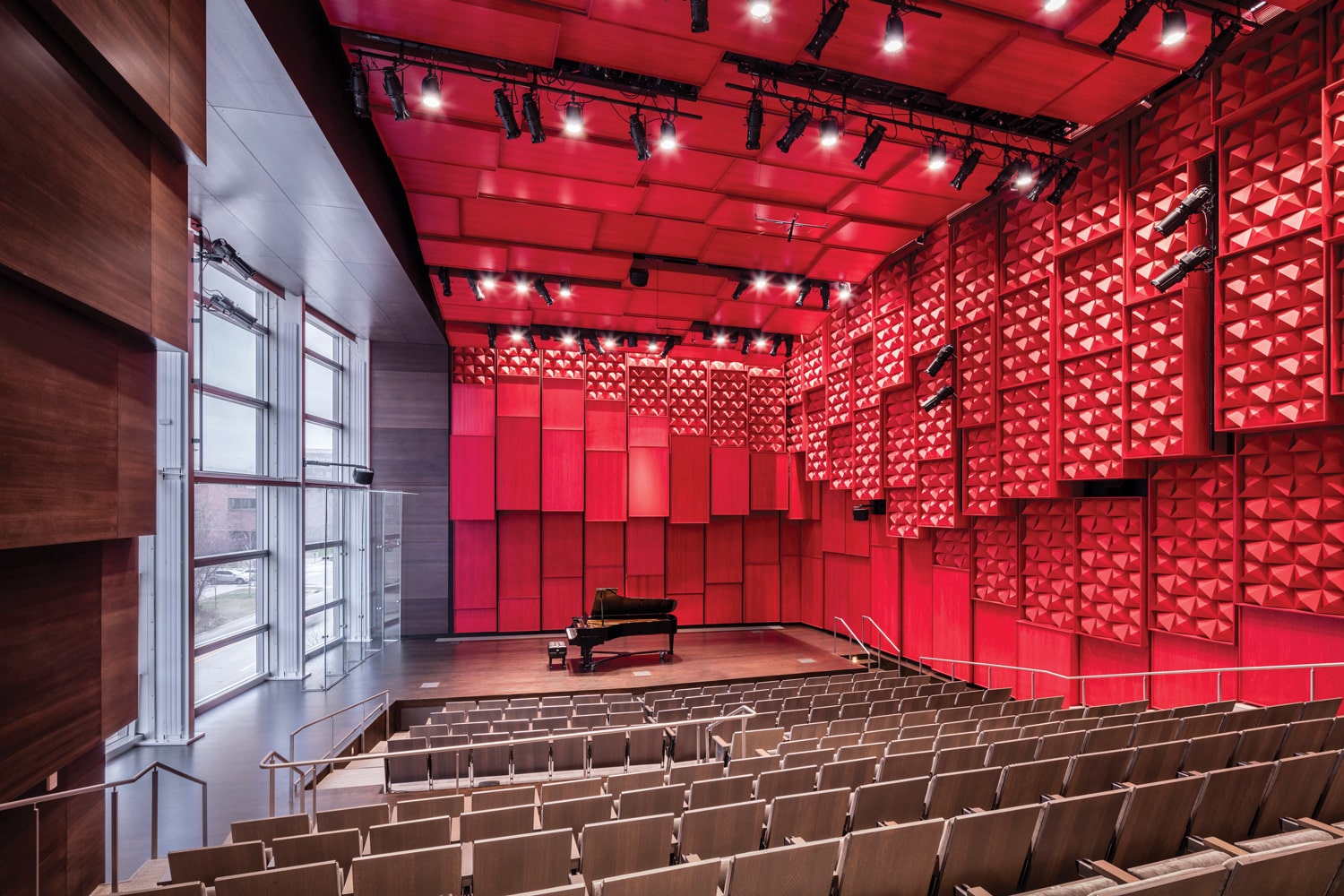
Acoustic diffusers are often used in theatres and concert halls to ensure even sound distribution. Photo courtesy of Adam Hunter/LMN Architects
Diffusion—or the spreading of sound evenly throughout a given environment—is one of the single most important aspects of acoustic architecture. Adequate diffusion is especially crucial when it comes to the design of theatres, concert halls, conference rooms, classrooms, lecture halls, and other spaces where echoing is not desired.
Diffusers are acoustic design elements used to control echoes and other sound aberrations in a room and work by radiating sound energy in many directions rather than reflecting it back at an equal angle (i.e. echoing). Because acoustic diffusers do not actually remove sound energy but instead distribute it evenly throughout a room they still produce a live sounding space, making them ideal for use in performance venues.
Acoustic diffusers may complement or be used as an alternative to sound absorbers and come in a range of shapes, sizes, and designs, making it extremely easy to find a solution that fits with the intended style or aesthetic of a room.
5. Acoustic Zoning
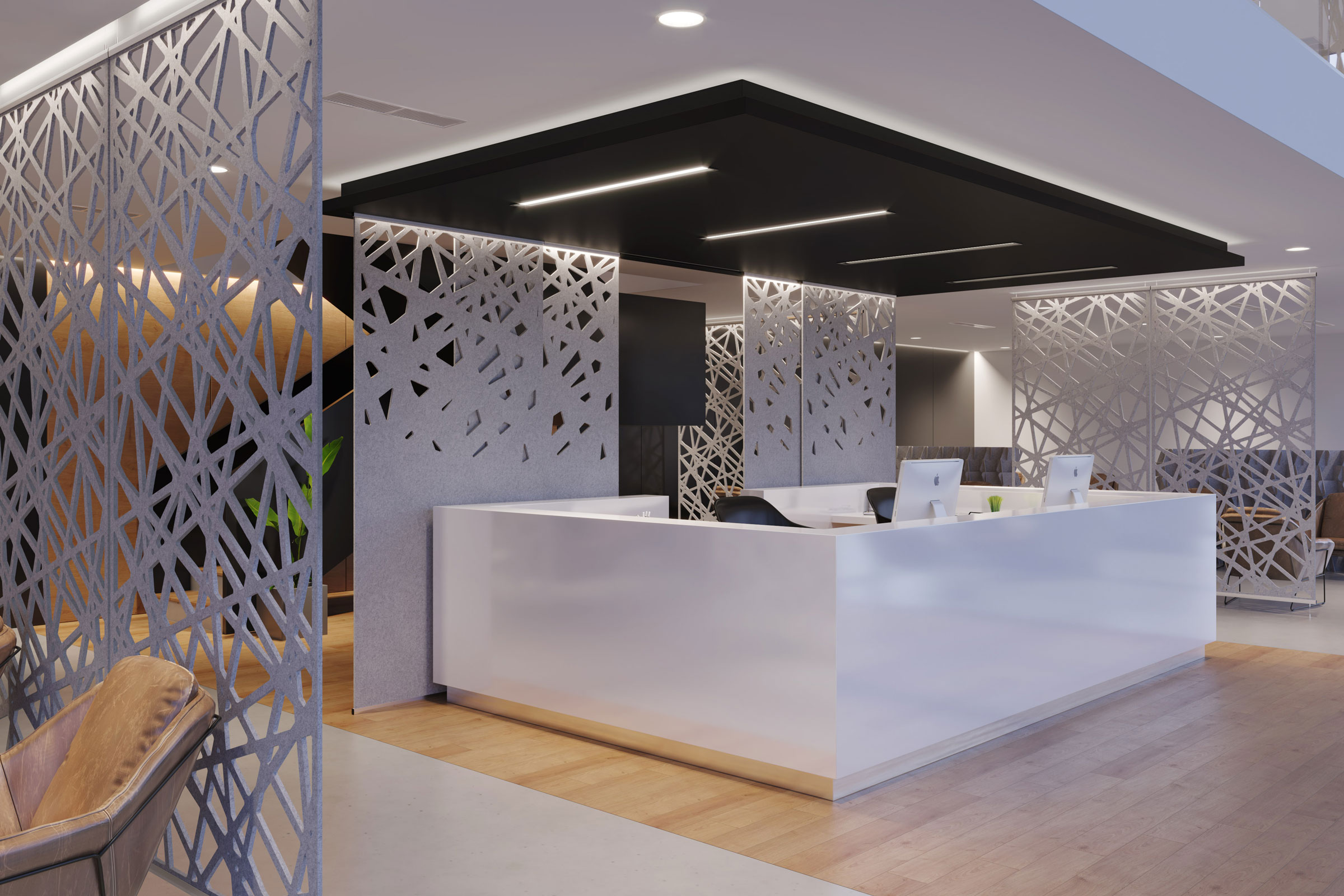
Acoustic dividers not only provide sound control, but they can help with privacy concerns for any temporary or permanent installation. Photo courtesy of Arktura
The idea behind interior acoustic zoning is to address a diverse range of acoustic needs for a successful working, learning, or living environment. Design adjacencies and details should be capable of supporting a full spectrum of sound—from quiet, meditative library areas to collaborative hubs.
Some of the best ways to incorporate this is using sound-absorbing materials, air gap technologies, best practice wall construction, and laminated/insulated glass enclosure solutions.
6. Flexible Design & Privacy
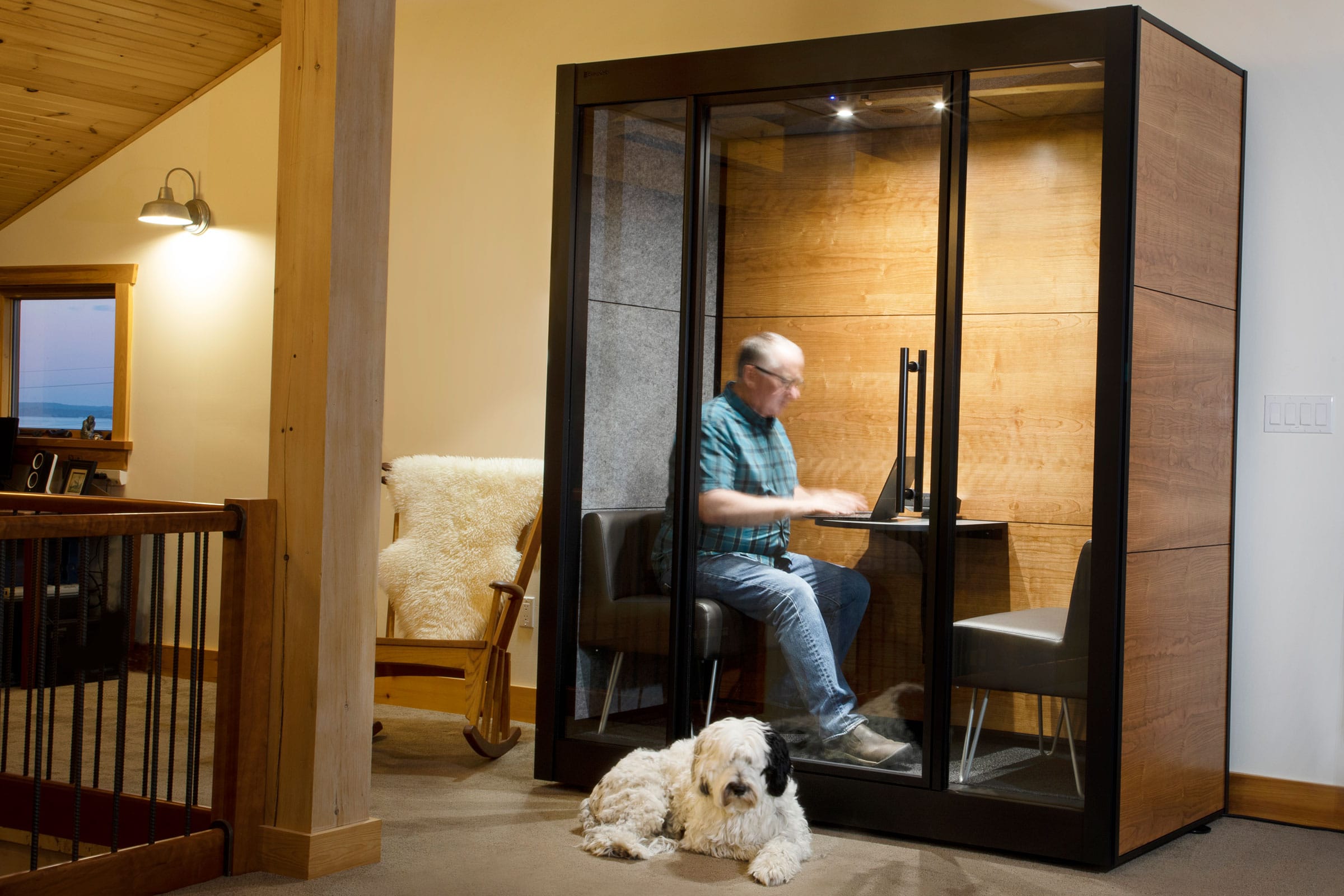
Photo courtesy of SnapCab Workspace
In large, open office areas it can become impossible to complete tasks that require some degree of privacy, like making confidential phone calls or meeting in small groups. An important acoustic design principle for office spaces is to allow flexibility and have areas where privacy can be obtained.
SnapCab has taken this issue and has developed potential solutions in the form of the SnapCab Focus, Meet 4 and Meet 6. The SnapCab Focus is an acoustically controlled single-person workspace. The SnapCab Meet 4 and Meet 6 are workspaces ideal for small team meetings of four and six people respectively, as well as breakaway sessions.
7. Sealing with Acoustic Caulk
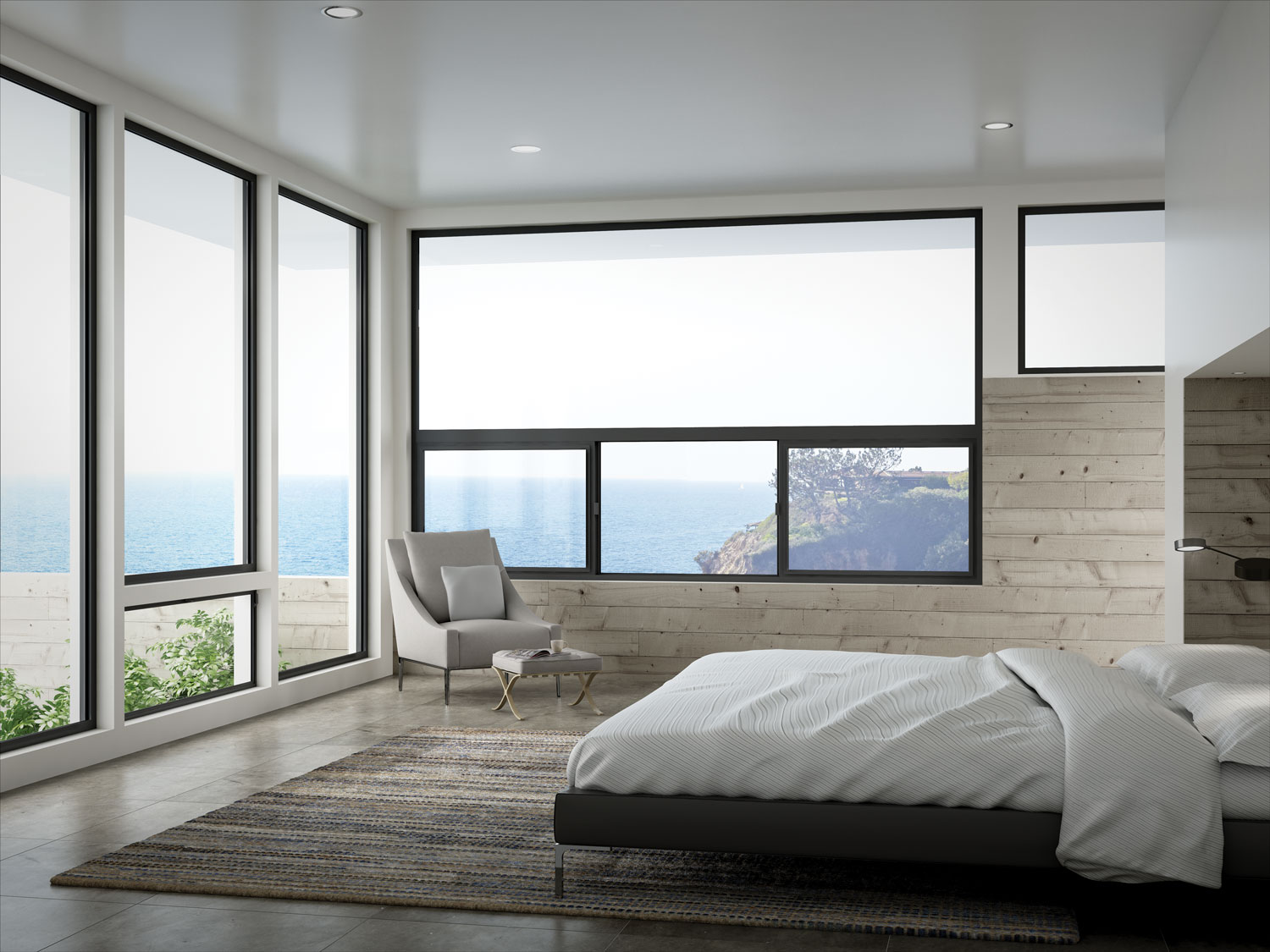
Sealing windows and other perimter openings with latex-based acoustic caulk can help prevent outside noise from from leaking in. Photo courtesy of Milgard
Just like air and moisture, sound can enter a building through gaps in improperly-sealed windows and other openings along a building’s exterior. This can be mitigated in large part through the application of acoustic caulk.
Unlike conventional silicone-based caulk, acoustic caulk is a latex-based product that remains rubbery and flexible permanently instead of hardening after application. This inherent flexibility ensures that acoustic caulk will not shrink or crack over time—something silicone-based caulk is prone to doing—thereby creating a better, longer-lasting soundproofing barrier.
8. Acoustical Steel Decking
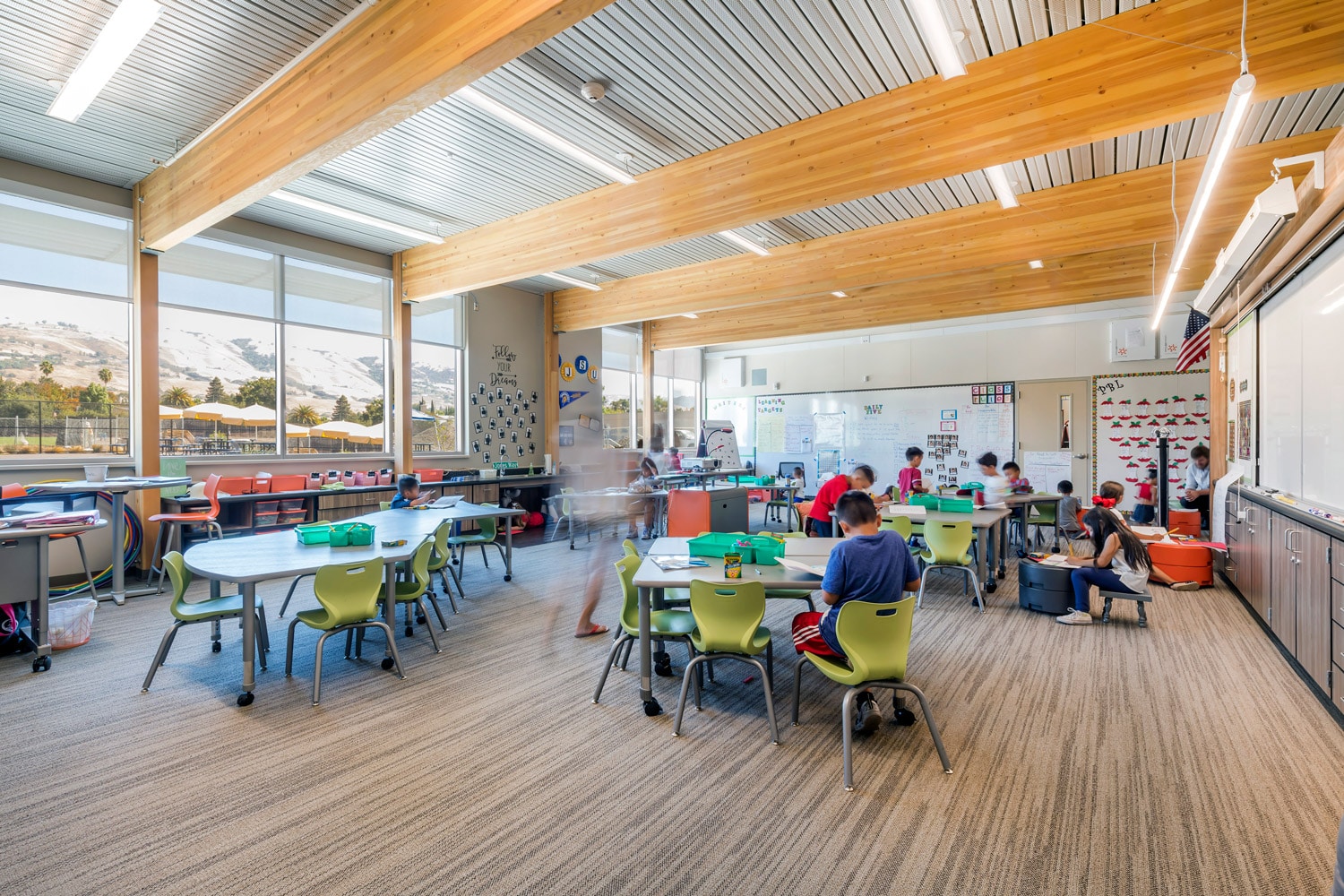
New Millennium’s Versa-Dek line of dovetail steel decking brings a clean lineal plank ceiling aesthetic. In addition to acoustical control the system opens the way to column-free spaces that are optimal for flexible-use classroom environments.
Photo courtesy of Architectural Photography
Acoustical steel decking—a type of deck profile that features perforated holes in the flutes of the deck and is used to support the insulating membrane of roofs and intermediate floors—is another common noise-reduction strategy used in construction.
There are two types of acoustical steel decking—non-cellular and cellular—both of which maintain some amount of sound-absorbing properties. Non-cellular acoustical steel decking is the industry standard, wherein the deck itself is exposed to noise from below and insulation is installed above the deck in-between each flute.
Cellular acoustical steel decking, on the other hand, features a perforated flat metal plate welded or riveted to the bottom of the steel deck, forming cavities (or cells) inside each flute. In addition to the insulation installed above the decking, these cells come pre-filled with insulation batts installed by the manufacturer.
“Steel deck acoustical products may provide the same noise reduction performance as standard mineral fiber, fiberglass, and other ceiling tile systems,” Marie Ortega, marketing team member at ASC Steel Deck, previously wrote for gb&dPRO.
9. Isolated Ceilings & Acoustic Clouds
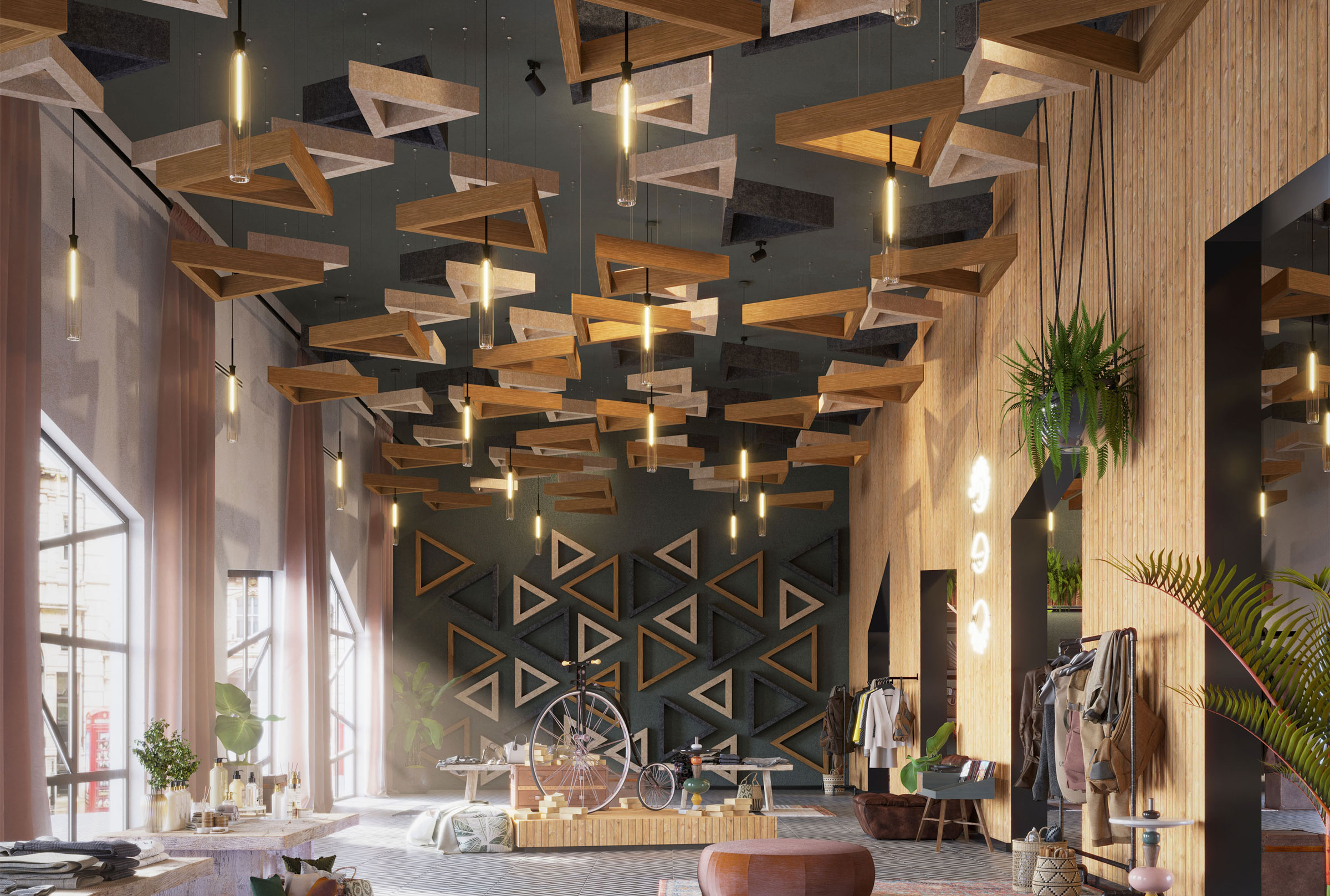
SoftShapes Tri brings versatility to your next project through wall and ceiling mounted acoustic clouds. Photo render courtesy of Arktura
Room acoustics can also be improved upon with the addition of isolated ceilings (also known as drop or suspended ceilings), a type of secondary ceiling system suspended below the main structural ceiling or ceiling deck.
Most isolated ceilings use a steel grid system and mineral fiber acoustic tiles hung using metal rods and wires; the length of these suspension wires varies depending the height of the roof structure and the desired ceiling height. Suspended ceiling systems help reduce noise by actively blocking it from traveling to an adjacent room or by absorbing the sound energy outright.
If only certain spaces in a room require additional soundproofing or if the structural ceiling is left uncovered for aesthetic purposes, acoustic clouds may be installed instead of a full isolated ceiling. Like suspended ceiling systems, acoustic clouds are made from sound absorption panels and are suspended from wires or rods from the main ceiling structure. Acoustic clouds function like miniature suspended ceilings and are typically installed overtop specific workspaces that require better sound control than surrounding areas.
10. Sound Attenuators

The installation of sound attenuators can help reduce mechanical HVAC noise that reverberates through a buidling’s ductwork. Photo by Sandra Steinbrecher
An area often overlooked in acoustic design is how mechanical systems, especially HVAC systems, contribute to interior noise pollution. One of the easiest ways to reduce mechanical noise in a building is through the installation of sound attenuators, a type of noise control acoustical treatment specifically designed to reduce the transmission of noise through HVAC ductwork.
Conventional internally-lined ductwork has some capacity to attenuate noise, but typically only in the mid- to high-frequency range, whereas sound attenuators are able to achieve broader band attenuation in relatively short lengths and so minimize low-frequency noises as well.
Most sound attenuators consist of the following:
- Baffle. A layer of perforated light gauge sheet metal inserted into the ductwork.
- Insulation. The attenuator’s baffle is then filled with sound-absorptive insulation.
- Shell. The outer layer of an attenuator is made from a non-perforated heavy gauge layer of sheet metal; the heavier the gauge, the less break-out and break-in noise is produced.
Sound attenuators are most effective when installed near ducted mechanical equipment, as this allows them to attenuate any noise that travels down the ductwork. Attenuators are available in both circular and rectangular forms and may be sized to fit ductwork of varying heights and widths.
Acoustic Design Examples
Interior acoustic design takes many forms and constant innovation in the field means new methods for controlling and reducing noise are always in the works.
Arktura
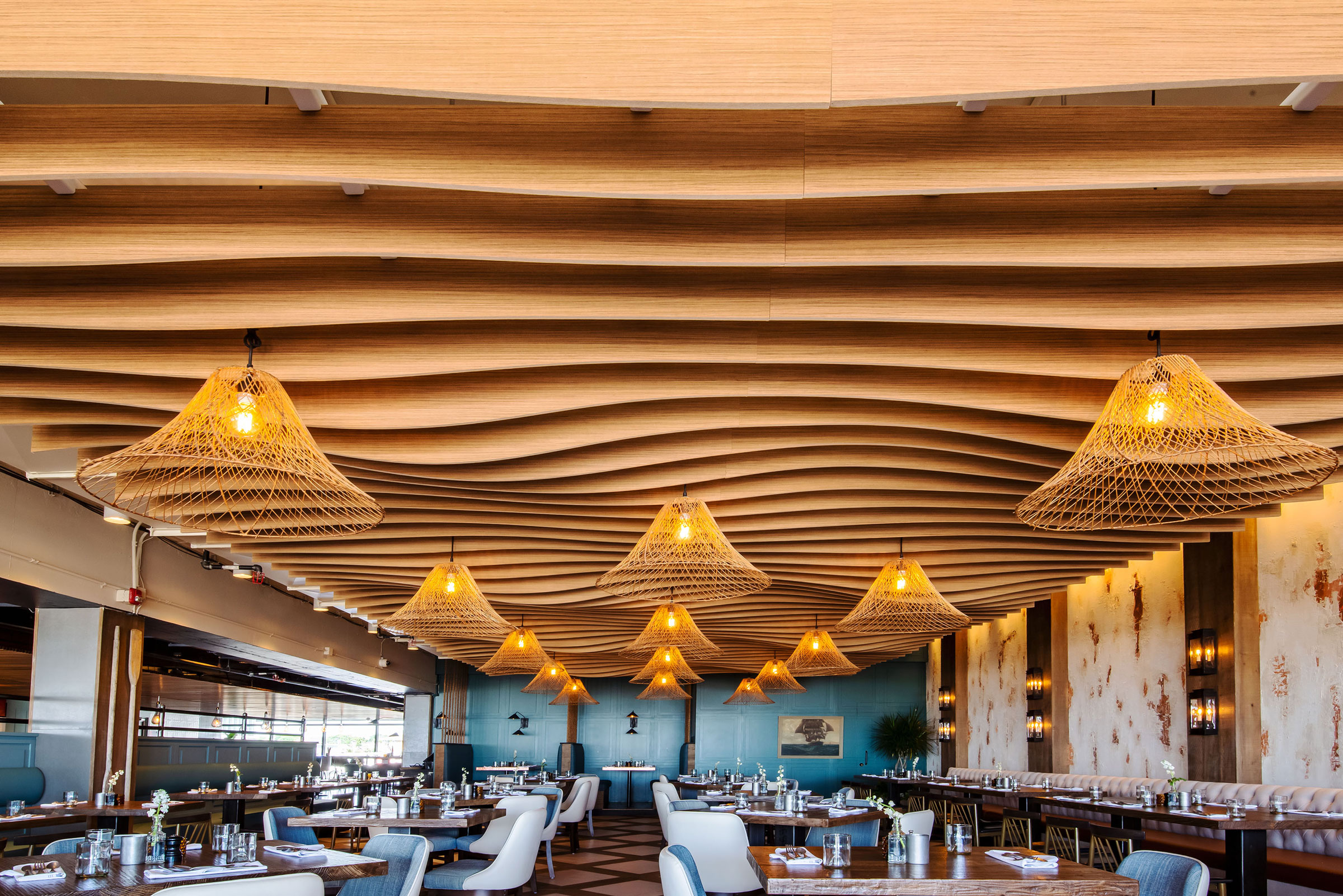
Not only do the waves of Atmosphera® Swell by Arktura look great here at Iron Whale Asbury in Asbury Park, they are also made of SoftSound material to help absorb excess noise. Designed by TSG Design. Photo by Megan Lawrence
Headquartered in Los Angeles, Arktura is one of the foremost manufacturers of innovative architectural systems and custom design solutions, including many of the acoustic design strategies mentioned in the section above. “From an acoustic performance perspective, our mission here at Arktura is to control noise and contribute to the comfort and wellness of our clients,” Moti Tavassoli, product designer at Arktura, previously told gb&d.
And that’s exactly what they deliver—from their wall and ceiling panels to their partitions, baffles, and ceiling clouds, Arktura helps provide improved noise control by way of the company’s proprietary Soft Sound® backing material. Soft Sound is an acoustic backing material used to construct (or which may be added to) a variety of Arktura’s products and serves to reduce and control reverberations, making for improved working environments and better listening experiences.
Arktura’s Atmosphera® and SoftGrid® line of baffles, for example, feature Soft Sound fins that make for tranquil, acoustically-sound environments that are also aesthetically-pleasing and stylistically unique.
Many of Arktura’s acoustic products—including the entire Vapor® line—also feature biophilic elements alongside their sound-dampening qualities, making use of organic patterns to help evoke a sense of nature while also reducing the amount of ambient noise.
Primacoustic

The Primacoustic Paintables acoustic panels come in a bright white primed panel that’s paintable—great for restaurants, offices, and more. Photo courtesy of Primacoustic
Primacoustic is another respected manufacturer of acoustic products, especially when it comes to wall and ceiling panels. Traditionally made from high-density glass wool, Primacoustic’s acoustic panels are fully sealed and ecologically sustainable, typically measuring a full 2-inches in thickness. Some of their panels—namely those in the EcoScapes series—are made from recycled PET plastic and contain no formaldehyde, VOCs, glues, or binders.
In instances where an entire wall needs acoustic treatment, Primacoustic’s TelaScapes Fabric Track System can be of assistance. “If you don’t want to hang individual panels on the wall, the TelaScapes allows you to cover a large surface and create more of a seamless custom look,” Bolomey says. Featuring a modular PVC track system fitted with easily-mountable panels covered in a durable stretch fabric, the TelaScapes system is compatible with almost any surface and greatly improves sound absorption.
In addition to their wall and ceiling panels, Primacoustic also carries acoustic clouds in a variety of shapes, colors, and sizes. Made from high-quality micro-mesh material and featuring resin hardened edges, these clouds can be covered in Broadway acoustically transparent fabric or coated in a paintable finish.
Autex Acoustics

Designed as a flexible active space with workstations for staff and service providers, the award-winning Rockingham Youth Centre project in New Zealand is designed to encourage collaboration in an acoustically pleasing space. Seen here is Autex Acoustics’ Frontier Axis product. Photo courtesy of Autex Acoustics
Originally established in 1967 as a textiles company, Autex Acoustics has since made a name for itself as one of the leading manufacturers of modern acoustic products and environmentally-friendly polyester insulation.
One of Autex Acoustic’s best-selling product lines is their Frontier line of acoustic ceiling and wall baffle systems. “Our Frontier line is very heavily used. That’s one of our more popular lines, designed for open-plan spaces to help limit unnecessary noise,” Tim Koldenhoven, North American sales director for Autex Acoustics, previously told gb&d. “That’s the hanging elements and items you see within the space.”
Designed for targeted sound absorption, the Frontier line is incredibly well-suited to open-plan workspaces and may be installed at variable distances to tune the acoustic effect, offering greater control over a room’s noise reduction solutions. The Frontier acoustic baffle system is available in both fin and raft form and boasts an NRC range between 0.70 and 1.05.
Autex Acoustics has also branched out beyond conventional acoustic panels to include products like Composition, a flexible acoustic wallcovering capable of being applied in vertical drops like traditional wallpaper. Composition doesn’t offer the same soundproofing ability as Autex’s panels and baffles—its NRC rating is only 0.40—but is instead designed to target speech frequencies and improve speech intelligibility, making it a great fit for classrooms and schools.
ASC Steel Deck

The Golden 1 Center sports arena was constructed partially from acoustical steel decking to ensure adequate noise control. Photo courtesy of ASC Steel Deck
As previously mentioned, acoustical steel decking is a noise-reduction strategy often used in stadiums, schools, and commercial building projects—indeed, steel decking can even help projects earn LEED credits for acoustic performance in the Indoor Environmental Quality category.
ASC Steel Deck is one of the leading manufacturers of both non-acoustic and acoustical steel decking, with their line of Acustadek® products being amongst the best-in-class for sound dampening. “ASC Steel Deck’s Acustadek products have been tested for sound absorption characteristics of assemblies,” Ortega writes. “Most Acustadek profile and perforation types meet a minimum threshold of 0.60 Noise Reduction Coefficient or greater.”
ASC Steel Deck also provides sound absorption data documentation for all of their Acustadek products.
Rafael Picó contributed to this article

